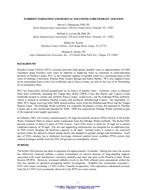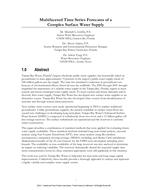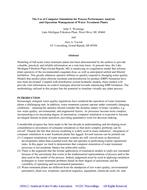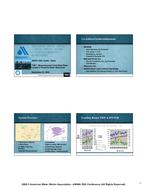Provide PDF Format
AWWA WQTC58935
- Turbidity Formation and Removal Following Forced-Draft Aeration
- Conference Proceeding by American Water Works Association, 11/02/2003
- Publisher: AWWA
$12.00$24.00
A forced draft aeration (FDA) process has been in operation for approximately 18 months at the Keller Water Treatment Plant, Pinellas County Utilities (PCU), Florida. During this time, the systemhas effectively removed sulfides, a major contaminant of concern because of long-standing impactsassociated with water disinfection, corrosion, turbidity and taste and odor in the Pinellas County WaterSystem (PCWS). However, increased turbidity levels in the FDA effluent were encountered within thefirst few months of operation prompting further investigation. Turbidity has consistently exceeded 1NTU with values exceeding 1.5 NTU within 3 months of operation. This represents a substantial increasefrom the 0.2 NTU level commonly observed in the WTP raw water stream.Visual inspection confirmed significant solids accumulation within the packing media and microbialanalysis performed for the County confirmed the presence of Thiothrix. This organism,whose numbers greatly increase in the FDA process, is at least partly responsible for the turbidityproblem. The Floridan Aquifer appears to be the source of Thiothrix (Brigmon et al. 1994). Note thatwhile Thiothrix is not reported to pose a human health threat, the slime like substances (EPS, orextrapolysaccharide) excreted by the bacterial biofilm could provide a protective matrix for a wide varietyof microorganisms to live and multiply, a condition which raises several fundamental concerns: adverse water quality impacts caused by sloughing of biofilm material into the WTP process stream;degradation of FDA treatment performance; and, mechanical failure of the FDA media supportstructure. The information presented in this paper looks at low-cost filtration methods for removingsolids sloughed from the FDA media into the process water. Based on organism size, cartridge filters and backwashablestrainers were identified as sieving processes potentially capable of mitigating turbidity following FDA.This study characterized the nature of solids accumulated/sloughed and evaluated turbidityremoval via either cartridge or strainer filtration techniques. Includes 2 references, tables, figures.
Related Products
AWWA SOURCES59190
Multifaceted Time Series Forecasts of a Complex Surface Water Supply..
$12.00 $24.00
AWWA WQTC55037
The Use of Computer Simulation for Process Performance Analysis and Operation Management of Water Tr..
$12.00 $24.00
AWWA DSS69212
Planning for and Achieving Water Loss Reduction in Birmingham, Alabama (An Update)..
$12.00 $24.00
AWWA WaterStats4ev2
WATER:\STATS 1996 Survey, Water Quality and General Information (MS EXCEL FORMAT)..
$66.00 $132.00





